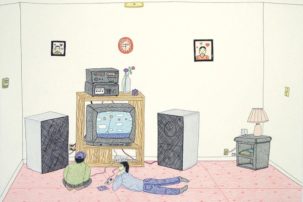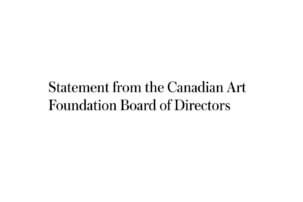Art and Health
Art materials, even natural ones, can be poisonous. So discovered Toronto artist Gillian Genser. In a viral first-person essay for Toronto Life, Genser describes: “I spent 15 years sanding and grinding mussel shells to create my sculptures. Then I was diagnosed with heavy-metal poisoning.” Mysterious symptoms were the tip-off. (Toronto Life)
The Royal Ontario Museum is launching participate in a prescriptions-for-art program. “Starting in January 2019, healthcare and social service providers can “prescribe” a visit to the ROM as a non-medicinal, therapeutic service to promote health and well-being,” says Daily Hive. “The ROM says that with a referral through the Social Prescription Program, individuals are given a ROM pass (valid for up to four visitors) to enjoy free general admission to the museum and its associated activities.” The announcement comes on the heels of a similar program at the Montreal Museum of Fine Arts. (Daily Hive)
Repatriation News
Artifacts, sacred objects and the remains of ancestors will soon be returned to Rainy River First Nations from the Royal Ontario Museum. That is where they have been stored for more than 30 years, says the CBC. “The Anishinaabe community in Northwestern Ontario is home to one of the largest known concentrations of burial mounds, located along the Rainy River. They were excavated and studied in the 1950s-1970s by Walter Kenyon, a curator at the ROM. Now the Rainy River First Nations and the ROM are in talks to return approximately 4,000 artifacts, including human remains.” (CBC)
A discussion on museums, repatriation and ownership. Lucy Bell of the Royal BC Museum joins Gail Lord of Lord Cultural Resources and Cara Krmpotich of the University of Toronto on a recent episode of The Agenda to discuss repatriation advancements. (The Agenda)
Inuit Art
A sealskin bracelet has blasted into space. That sealskin bracelet by Inuk designer Victoria Okpik was on the most recent shuttle launch in Russia along with Canadian astronaut David Saint-Jacques. “It’s a proud moment for me, and I’m sure other Inuit feel the same way,” Okpik told the CBC. (CBC)
The Pootoogook family is in focus in California. “‘Akunnittinni: A Kinngait Family Portrait,’ at the Armory Center for the Arts in Pasadena through the middle of December, presents work by three generations of artists from a single Inuit family: Pitseolak Ashoona, Napachie Pootoogook and Annie Pootoogook,” writes Carolina Miranda in the Los Angeles Times. Navajo curator Andrea Hanley tells the Times, “I come from a matrilineal tribe…I was really drawn to this idea of generations of these indigenous women; they were all coming from one family, and it’s a really strong family voice. But they’re each very different.” (LA Times)
Comings and Goings
Longtime New Brunswick art centre Struts has finally bought its building. The announcement was made on Facebook earlier this week. The building is 7 Lorne Street in Sackville, and the purchase will permit the artist-run centre a measure of security as it moves into the future. (Facebook)
Galerie Trois Points in Montreal is closing. The gallery had been around for 30 years in total, with 10 of those being under the reins of its current owners. “Hearts tight but very serene, we are sharing with you today that the current exhibition at the gallery will be our last,” says a recent email. “The gallery will definitely close its beautiful glass doors on December 15th.” (via email)
Staffing changes
There are some new faces at aceartinc. in Winnipeg. “Tani Lyn Miki has been appointed interim director of aceartinc. in Winnipeg and Christina Hajjar has been selected as the programming assistant,” says Galleries West. “Miki has a BFA in art history from the University of Manitoba and has worked for more than 15 years for not-for-profit cultural organizations in Toronto and Winnipeg. Hajjar is a first-generation Lebanese-Canadian queer femme emerging artist, writer and organizer based in Winnipeg.” (Galleries West)
Christiana Myers has been awarded the latest Canadian Art Editorial Mentorship. The Saint John–based curator and artist will work in our offices for the 11-week Winter 2018/2019 mentorship. (Canadian Art)
Art Basel Miami
Some of the early Art Basel sales are in. And Montreal-born artist Philip Guston’s works are among them. According to AXA Art, Philip Guston’s Shoe Head (1976) went for $7.5 million US from Hauser & Wirth, while another Guston painting went for $2,750,000 US to a European collection. (press release)
A swimsuit collaboration is just one of the Canadian offerings in Miami. One of painter Sarah Cale’s canvases has ended up on a MINNOW Bathers bikini available now at the Art Metropole booth at Art Basel Miami. We’ve rounded up some of the other Canadians down south for the big fairs week. (Canadian Art)
Awards
Winners of three Montreal art prizes have been announced: of the Prix Pierre-Ayot, Prix Louis-Comtois and new Cultural Diversity in the Visual Arts Award. The winners are Adam Basanta, Cynthia Girard-Renard and Hua Jin, respectively. (Canadian Art)
TIFF has announced its top 10 Canadian films of the year. It’s actually 20 films in total: 10 features and 10 shorts. Among them are Anthropocene by Jennifer Baichwal, Nicholas de Pencier, and Edward Burtynsky; the first Haida-language feature film ever, Sgaawaay K’uuna (Edge of the Knife) by Gwaai Edenshaw and Helen Haig-Brown; and Biidaaban (The Dawn Comes) by Amanda Strong. (press release)
The National Gallery of Canada has a new art prize—for artist-run centres. The prize comes from “$1.3 million donated by John Lacey and his late wife Naomi Lacey in support of the Naomi and John Lacey Art Incubator Prize, which will recognize exceptional talent at artist-run centres and in small galleries across the country,” says an NGC release. More details are forthcoming. (press release)
Big Shows
Rubens is coming to Toronto. The exhibition “Early Rubens,” featuring over 30 large-scale Rubens paintings—including several never before shown in North America—and about 20 works on paper opens at the AGO next year. Specifically, it opens October 12, 2019, and continues to January 5, 2020. The show is organized with Fine Arts Museums, San Francisco and the AGO. (press release)
Full artist list announced for Quebec City biennial Manif d’art. The release includes artists in the major exhibition, solo exhibitions and public installations, and represents a range of Quebec, Canadian and international artists. Also this year: a biennial program for children and families, and a conference for academics and theorists. The biennial opens in February 2019. (Canadian Art)
Passages
Nancy Paterson has died. Pioneering video artist and cyberfeminist Nancy Paterson passed on November 28 due to cancer. She was 60 years old, and had taught at OCAD for 28 years. She was also involved with Interaccess and Charles Street Video. “Paterson’s career has spanned 30 years and her influence has been felt both nationally and internationally in the field of new media art. Through the unique application of custom-made equipment, Paterson’s works are socially critical and technically complex, expressing a feminist perspective on the impacts of technology in society,” wrote the curator of her recent survey, Shauna Jean Doherty. (OCAD University, Globe Obituaries, SJD Curatorial)







